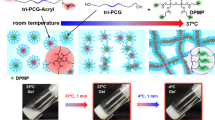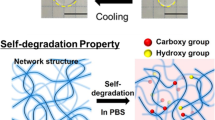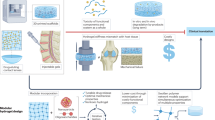Abstract
Polymers that display a physicochemical response to stimuli are widely explored as potential drug-delivery systems1,2,3,4. Stimuli studied to date include chemical substances and changes in temperature, pH and electric field. Homopolymers or copolymers of N-isopropylacrylamide5,6 and poly(ethylene oxide)–poly(propylene oxide)–poly(ethylene oxide) (known as poloxamers)7 are typical examples of thermosensitive polymers, but their use in drug delivery is problematic because they are toxic and non-biodegradable. Biodegradable polymers used for drug delivery to date have mostly been in the form of injectable microspheres or implant systems, which require complicated fabrication processes using organic solvents8. Such systems have the disadvantage that the use of organic solvents can cause denaturation when protein drugs are to be encapsulated. Furthermore, the solid form requires surgical insertion, which often results in tissue irritation and damage. Here we report the synthesis of a thermosensitive, biodegradable hydrogel consisting of blocks of poly(ethylene oxide) and poly(L-lactic acid). Aqueous solutions of these copolymers exhibit temperature-dependent reversible gel–sol transitions. The hydrogel can be loaded with bioactive molecules in an aqueous phase at an elevated temperature (around 45 °C), where they form a sol. In this form, the polymer is injectable. On subcutaneous injection and subsequent rapid cooling to body temperature, the loaded copolymer forms a gel that can act as a sustained-release matrix for drugs.
This is a preview of subscription content, access via your institution
Access options
Subscribe to this journal
Receive 51 print issues and online access
$199.00 per year
only $3.90 per issue
Buy this article
- Purchase on Springer Link
- Instant access to full article PDF
Prices may be subject to local taxes which are calculated during checkout




Similar content being viewed by others
References
Langer, R. New methods of drug delivery. Science 249, 1527–1533 (1990).
Ishihara, K., Muramoto, N. & Shinohara, I. Controlled release of organic substances using polymer membrane with responsive function for amino compounds. J. Appl. Polym. Sci. 29, 211–217 (1984).
Thomas, J. L., You, H. & Tirrel, D. A. Tuning the response of a pH-sensitive membrane switch. J. Am. Chem. Soc. 117, 2949–2950 (1995).
Kwon, I. C., Bae, Y. H. & Kim, S. W. Electrically erodible polymer gel for controlled release of drugs. Nature 354, 291–293 (1991).
Bae, Y. H., Okano, T., Hsu, R. & Kim, S. W. Thermo-sensitive polymers as on-off switches for drug release. Makromol. Chem. Rapid Commun. 8, 481–485 (1987).
Chen, G. H. & Hoffman, A. S. Graft copolymers that exhibit temperature-induced phase transitions over a wide range of pH. Nature 373, 49–52 (1995).
Malstom, M. & Lindman, B. Self-assembly in aqueous block copolymer solutions. Macromolecules 25, 5440–5445 (1992).
Youxin, L. & Kissel, T. Synthesis and properties of biodegradable ABA triblock copolymers consisting of poly(L-lactic acid) or poly(L-lactic-co-glycolic acid) A-blocks attached to central poly(oxyethylene) B-blocks. J. Controlled Release 27, 247–257 (1993).
Alexandrisdis, P., Holzwarth, J. F. & Hatton, T. A. Micellization of poly(ethylene oxide)-poly(propylene oxide)-poly(ethylene oxide) triblock copolymers in aqueous solution: Thermodynamics of copolymer association. Macromolecules 27, 2414–2425 (1994).
Moritz, A. R. & Henrique, F. C. J Studies on thermal injury II. The relative importance of time and surface temperature in the causation of cutaneous burns. Am. J. Pathol. 23, 695–720 (1947).
Ronneberger, B., Kao, W. J., Anderson, J. A. & Kissel, T. In-vivo biocompatibility study of ABA triblock copolymers consisting of poly(L-lactic-co-glycolic acid) A blocks attached to central poly(oxyethylene) B blocks. J. Biomed. Mater. Res. 30, 31–40 (1996).
Zhu, K. J., Lin, X. & Yang, S. Preparation, characterization, and properties of polylactide (PLA)-poly(ethylene glycol) (PEG) copolymers: potential drug carriers. J. Appl. Polym. Sci. 39, 1–9 (1990).
Wout, Z. G. M., Pec, E. A., Maggiore, R. H., Palicharla, P. & Johnston, T. Poloxamer 407-mediated changes in plasma cholesterol and triglycerides following intraperitoneal injection to rats. J. Parenteral Sci. Technol. 46, 192–200 (1992).
Acknowledgements
We thank to G. G. Krueger for comments on dermatological issues and J. S. Kim for technical assistance. D. S. Lee was supported by the Ministry of Education of Korea. This work was supported by the University of Utah Research Foundation.
Author information
Authors and Affiliations
Rights and permissions
About this article
Cite this article
Jeong, B., Bae, Y., Lee, D. et al. Biodegradable block copolymers as injectable drug-delivery systems. Nature 388, 860–862 (1997). https://doi.org/10.1038/42218
Received:
Accepted:
Issue Date:
DOI: https://doi.org/10.1038/42218
This article is cited by
-
Design of dual stimuli-responsive gels with physical and chemical properties that vary in response to light and temperature and cell behavior on their surfaces
Polymer Journal (2024)
-
Removal of basic fuchsin from aqueous solution using polyacrylamide and gellan gum-based hydrogels
Chemical Papers (2024)
-
Stride Strategy to Enable a Quasi-ergodic Search of Reaction Pathways Demonstrated by Ring-opening Polymerization of Cyclic Esters
Chinese Journal of Polymer Science (2023)
-
Nanostructured block copolymer muscles
Nature Nanotechnology (2022)
-
Thermo-responsive release of rhodamine B in the pore-selective poly(N-isopropylacrylamide) immobilized honeycomb-patterned porous film
Polymer Bulletin (2022)
Comments
By submitting a comment you agree to abide by our Terms and Community Guidelines. If you find something abusive or that does not comply with our terms or guidelines please flag it as inappropriate.



